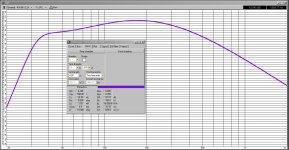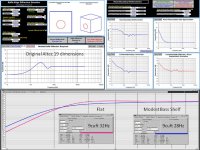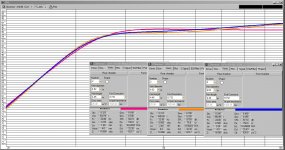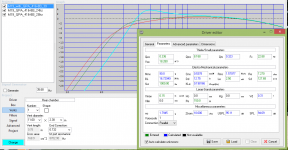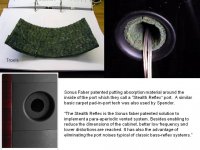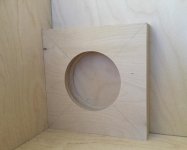Looks good enough - although the original had the port to the left side of the woofer, with XO controls to the right.
Make an MDF template (see, it is good for something 😀) and rough cut with jig saw, then clean up with pattern following bit . I find that works much better with BB plywood than plunging by hand - unless using a massive router such as the Porter Cable 7519. If you want to get really fussy, the radiused inside corners can be squared up with a Douzuki draw saw .
Great advice. Going to try to get this going for the weekend. That should give me time to make some practice cuts first. Hopefully the home store has what I need.
My idea is to keep crossover to the rear and most likely detached. I'm going to try at least 2 XO versions so keeping them out of the cabinet will make things easier.
BHamm
The Qts parameters of the early Altec 416 are different from the late Altec 416, and are also different from the latest GPA 416. I have Altec 416 datasheets with Qts of 0.24, 0.32, 0.34.
WinISD sims calculate that a rectangle port of 11" * 2.375" must be 3.4" - 4" deep to pass the modern Thiele/Small ported box math. .....MUCH DEEPER than 0.75" plywood.
So,
Do you trust old school Altec?
Do you trust 40 years of Thiele math successful designs?
Do you have some good Red Wine?
WinISD sims calculate that a rectangle port of 11" * 2.375" must be 3.4" - 4" deep to pass the modern Thiele/Small ported box math. .....MUCH DEEPER than 0.75" plywood.
So,
Do you trust old school Altec?
Do you trust 40 years of Thiele math successful designs?
Do you have some good Red Wine?
Attachments
Bhamm,
Linesource is right.
( As a consequence ), you'll need to measure your 2 woofers to obtain their actual TS parameters .
Otherwise, any porting scheme you embrace is just a random act of ( misplaced ) faith ( especially true with Altec-GPA ).
Buy DATS v2 or WT2 or make a measurement jig to use with REW or( ARTA-LIMP ) to measure your woofers .
🙂
Linesource is right.
( As a consequence ), you'll need to measure your 2 woofers to obtain their actual TS parameters .
Otherwise, any porting scheme you embrace is just a random act of ( misplaced ) faith ( especially true with Altec-GPA ).
Buy DATS v2 or WT2 or make a measurement jig to use with REW or( ARTA-LIMP ) to measure your woofers .
🙂
No 416 that I've measured was anywhere near the specs I've seen around the web. So I gave up on that. 😉 I have measured 515s that were in the ballpark.
To tune my 416-8A woofer in the 828 box (A7) I had to just keep changing the port area, measuring and listening. I did start with a simulation, but went from there. That is not an option for Bhamm's boxes, tho, as he's not going to want to be cutting and recutting ports.
To tune my 416-8A woofer in the 828 box (A7) I had to just keep changing the port area, measuring and listening. I did start with a simulation, but went from there. That is not an option for Bhamm's boxes, tho, as he's not going to want to be cutting and recutting ports.
FWIW, my ports ended up at about 96 sq in. with a depth of 0.75" However, they were at the bottom, so that means one sidewall and floor effect, which the model 19 does not have. My cabinets were effectively 11 cubic feet in volumelWinISD sims calculate that a rectangle port of 11" * 2.375" must be 3.4" - 4" deep to pass the modern Thiele/Small ported box math. .....MUCH DEEPER than 0.75" plywood.
On that note, here's a 416-8b measured with a WT2
416-8b 11 march 2016 unit 1
Buffer[1] Vas Ver 7.01
Completed: Thu Mar 10 09:31:05 2016
Drive level 100.000% [3.593 mA]
Sine,LoZP(LV/LA)->Vas,21 pts
;------------------------------------------------------------------
Re = 6.6810 ohms
Fs = 28.1566 Hz
Zmax = 116.1940 ohms
Qes = 0.3222
Qms = 5.2822
Qts = 0.3037
Le = 1.2820 mH (at 1 kHz)
Diam = 330.2000 mm ( 13.0000 in )
Sd = 85633.5536 mm^2(132.7323 in^2)
Vas = 495.6034 L ( 17.5021 ft^3)
BL = 15.6947 N/A
Mms = 67.1581 g
Cms = 475.7533 uM/N
Kms = 2101.9299 N/M
Rms = 2.2493 R mechanical
Efficiency = 3.2258 %
Sensitivity= 97.1044 dB @1W/1m
Sensitivity= 97.8869 dB @2.83Vrms/1m
Krm = 149.253E-06 ohms Freq dependent resistance
Erm = 1.105E+00 Rem=Krm*(2*pi*f)^Erm
Kxm = 20.943E-03 Henries Freq dependent reactance
Exm = 681.204E-03 Xem=Kxm*(2*pi*f)^Exm
;------------------------------------------------------------------
Ftest = 23.409 Hz
Ftest/Fms = 0.8314
Test Mass used = 30.0000 g (Equal to 6.0 nickels)
Test Mass (Ft=Fms*0.90) = 15.753 g (Add -14.247g for Ft=25.341)
Test Mass (Ft=Fms*0.75) = 52.234 g (Add 22.234g for Ft=21.117)
And here is a 416-8C
Altec 416-8C unit 1
Buffer[1] Vas Ver 5.00
Completed: Tue Dec 04 11:09:21 2012
Drive level 100.000 % [ 3.602 mA]
Sine,LoZP(LV/LA)->Vas,23 pts
;------------------------------------------------------------------
Re = 7.1663 ohms
Fs = 29.9457 Hz
Zmax = 104.5127 ohms
Qes = 0.3865
Qms = 5.2503
Qts = 0.3600
Le = 1.1471 mH (at 1 kHz)
Diam = 330.2000 mm ( 13.0000 in )
Sd =85633.5536 mm^2(132.7323 in^2)
Vas = 445.2330 L ( 15.7233 ft^3)
BL = 15.1843 N/A
Mms = 66.0901 g
Cms = 427.4003 uM/N
Kms = 2339.7271 N/M
Rms = 2.3685 R mechanical
Efficiency = 2.9066 %
Sensitivity= 96.6519 dB @1W/1m
Sensitivity= 97.1298 dB @2.83Vrms/1m
Krm = 66.478E-06 ohms Freq dependent resistance
Erm = 1.116E+00 Rem=Krm*(2*pi*f)^Erm
Kxm = 24.549E-03 Henries Freq dependent reactance
Exm = 660.957E-03 Xem=Kxm*(2*pi*f)^Exm
;------------------------------------------------------------------
Ftest = 26.105 Hz
Ftest/Fms = 0.8717
Test Mass used = 20.8800 g (Equal to 4.2 nickels)
Test Mass (Ft=Fms*0.90) = 15.503 g (Add -5.377g for Ft=26.951)
Test Mass (Ft=Fms*0.75) = 51.403 g (Add 30.523g for Ft=22.459)
416-8b 11 march 2016 unit 1
Buffer[1] Vas Ver 7.01
Completed: Thu Mar 10 09:31:05 2016
Drive level 100.000% [3.593 mA]
Sine,LoZP(LV/LA)->Vas,21 pts
;------------------------------------------------------------------
Re = 6.6810 ohms
Fs = 28.1566 Hz
Zmax = 116.1940 ohms
Qes = 0.3222
Qms = 5.2822
Qts = 0.3037
Le = 1.2820 mH (at 1 kHz)
Diam = 330.2000 mm ( 13.0000 in )
Sd = 85633.5536 mm^2(132.7323 in^2)
Vas = 495.6034 L ( 17.5021 ft^3)
BL = 15.6947 N/A
Mms = 67.1581 g
Cms = 475.7533 uM/N
Kms = 2101.9299 N/M
Rms = 2.2493 R mechanical
Efficiency = 3.2258 %
Sensitivity= 97.1044 dB @1W/1m
Sensitivity= 97.8869 dB @2.83Vrms/1m
Krm = 149.253E-06 ohms Freq dependent resistance
Erm = 1.105E+00 Rem=Krm*(2*pi*f)^Erm
Kxm = 20.943E-03 Henries Freq dependent reactance
Exm = 681.204E-03 Xem=Kxm*(2*pi*f)^Exm
;------------------------------------------------------------------
Ftest = 23.409 Hz
Ftest/Fms = 0.8314
Test Mass used = 30.0000 g (Equal to 6.0 nickels)
Test Mass (Ft=Fms*0.90) = 15.753 g (Add -14.247g for Ft=25.341)
Test Mass (Ft=Fms*0.75) = 52.234 g (Add 22.234g for Ft=21.117)
And here is a 416-8C
Altec 416-8C unit 1
Buffer[1] Vas Ver 5.00
Completed: Tue Dec 04 11:09:21 2012
Drive level 100.000 % [ 3.602 mA]
Sine,LoZP(LV/LA)->Vas,23 pts
;------------------------------------------------------------------
Re = 7.1663 ohms
Fs = 29.9457 Hz
Zmax = 104.5127 ohms
Qes = 0.3865
Qms = 5.2503
Qts = 0.3600
Le = 1.1471 mH (at 1 kHz)
Diam = 330.2000 mm ( 13.0000 in )
Sd =85633.5536 mm^2(132.7323 in^2)
Vas = 445.2330 L ( 15.7233 ft^3)
BL = 15.1843 N/A
Mms = 66.0901 g
Cms = 427.4003 uM/N
Kms = 2339.7271 N/M
Rms = 2.3685 R mechanical
Efficiency = 2.9066 %
Sensitivity= 96.6519 dB @1W/1m
Sensitivity= 97.1298 dB @2.83Vrms/1m
Krm = 66.478E-06 ohms Freq dependent resistance
Erm = 1.116E+00 Rem=Krm*(2*pi*f)^Erm
Kxm = 24.549E-03 Henries Freq dependent reactance
Exm = 660.957E-03 Xem=Kxm*(2*pi*f)^Exm
;------------------------------------------------------------------
Ftest = 26.105 Hz
Ftest/Fms = 0.8717
Test Mass used = 20.8800 g (Equal to 4.2 nickels)
Test Mass (Ft=Fms*0.90) = 15.503 g (Add -5.377g for Ft=26.951)
Test Mass (Ft=Fms*0.75) = 51.403 g (Add 30.523g for Ft=22.459)
Sorry to hijack this thread, but found it very interesting.
I have a Faital Pro 15PR400 in a 5.5Cuft box (150litre) tuned to 35hz and I get an unpleasant boxy boomy upper bass sound that can ruin what could otherwise be a great listening session. I this a result of the box and tuning or does the driver need a notch filter to iron out any nasties? I am using the 4ohm version crossed over at 400hz.
I have a Faital Pro 15PR400 in a 5.5Cuft box (150litre) tuned to 35hz and I get an unpleasant boxy boomy upper bass sound that can ruin what could otherwise be a great listening session. I this a result of the box and tuning or does the driver need a notch filter to iron out any nasties? I am using the 4ohm version crossed over at 400hz.
Bhamm,
Linesource is right.
( As a consequence ), you'll need to measure your 2 woofers to obtain their actual TS parameters .
Otherwise, any porting scheme you embrace is just a random act of ( misplaced ) faith ( especially true with Altec-GPA ).
Buy DATS v2 or WT2 or make a measurement jig to use with REW or( ARTA-LIMP ) to measure your woofers .
🙂
I agree measuring my specific drivers may give me the most accurate data to go off of, but I'm not going to do that at this time.
So, second best may be to use the most current measurements such as Zel has provided. I don't think the specs are so far off that it will ruin any chance to make good sound. Sometimes you have to just roll with it.
I did call Bill at GPA today and asked him about the published T-S parameters for the GPA 416 driver. He assured me they were accurate with possibly very minute differences on average-- good enough for me.
Hi,
When I do a "sim" ( within WinISD ) using the TS specs provided by GPA ( at this link ) , along with the current box & port sizings, I get a pretty large bass peak ( of @ 3.5db ) at 48hz.
Is this what you're after ( or do you get something else from your sims )?
🙂
When I do a "sim" ( within WinISD ) using the TS specs provided by GPA ( at this link ) , along with the current box & port sizings, I get a pretty large bass peak ( of @ 3.5db ) at 48hz.
Is this what you're after ( or do you get something else from your sims )?
🙂
Last edited:
THE BIG PICTURE: For low frequencies up to about 200Hz, room interaction from the floor and walls will have a significant affect on the bass SPL shape. Hence, the flatest in-room SPL often comes from a "bass-shelf" cabinet alignment where the cabinet+port are tuned for a downward sloping SPL which complements the rising wall gain. For the GPA 416-8B, a port tuning from 32Hz for a flat SPL, down to 28Hz from a longer port bass shelf could be optimum for your room. Diffraction and Boundary Simulator is a free tool you can use to optimize speaker-room placement and bass port tuning.
Two 4" diameter ports 4.45" long provide F3~32Hz in 9cuft cabinet volume still looks like a good generic tuning.
==================
FROM GPA DATASHEETS:
--GPA 416-8B has has an Alnico motor with Qts ~0.336
--GPA 416-8C has a Ferrite magnet with Qts~0.22
I could not find a 416-8A in the GPA products. Did GPA re-cone an old Altec driver?
If you own the GPA 416-8B:
--two 4" diameter ports 4.45" long provide F3~32Hz in 9cuft cabinet volume.
--two 4" diameter ports 4.93" long provide F3~31Hz in 9cuft cabinet volume.
--two 4" diameter ports 5.47" long provide F3~30Hz in 9cuft cabinet volume.
---from the simulation, F3 ~ 31-32Hz has the flattest SPL
for a 0.75" plywood only port....11" x 2.35" x 0.75" has F3 ~39.7Hz port tuning for 9cuft volume 9396Hz resonance
If you own the GPA-415-8C, then
--two 4" diameter ports 3.24" long provide F3~35Hz in 9cuft cabinet volume.
--two 4" diameter ports 3.61 long provide F3~34Hz in 9cuft cabinet volume.
--two 4" diameter ports 4.01" long provide F3~33Hz in 9cuft cabinet volume.
---from the simulation, F3 ~ 35 has the flattest SPL
for a 0.75" plywood only port...11" x 2.35" x 0.75" has F3 ~39.4Hz port tuning for 9cuft volume 9664Hz resonance
Two 4" diameter ports 4.45" long provide F3~32Hz in 9cuft cabinet volume still looks like a good generic tuning.
==================
FROM GPA DATASHEETS:
--GPA 416-8B has has an Alnico motor with Qts ~0.336
--GPA 416-8C has a Ferrite magnet with Qts~0.22
I could not find a 416-8A in the GPA products. Did GPA re-cone an old Altec driver?
If you own the GPA 416-8B:
--two 4" diameter ports 4.45" long provide F3~32Hz in 9cuft cabinet volume.
--two 4" diameter ports 4.93" long provide F3~31Hz in 9cuft cabinet volume.
--two 4" diameter ports 5.47" long provide F3~30Hz in 9cuft cabinet volume.
---from the simulation, F3 ~ 31-32Hz has the flattest SPL
for a 0.75" plywood only port....11" x 2.35" x 0.75" has F3 ~39.7Hz port tuning for 9cuft volume 9396Hz resonance
If you own the GPA-415-8C, then
--two 4" diameter ports 3.24" long provide F3~35Hz in 9cuft cabinet volume.
--two 4" diameter ports 3.61 long provide F3~34Hz in 9cuft cabinet volume.
--two 4" diameter ports 4.01" long provide F3~33Hz in 9cuft cabinet volume.
---from the simulation, F3 ~ 35 has the flattest SPL
for a 0.75" plywood only port...11" x 2.35" x 0.75" has F3 ~39.4Hz port tuning for 9cuft volume 9664Hz resonance
Attachments
Correction on my 1st post--my driver is the current production 416-8B.
EarlK, thank you for the sims, and no, I would not want the 3+ db bass hum at 48Hz, even though I live on the west coast ; )
So my latest thought of going with a slot port reveals it does not sim as nicely as the 2 round ports discussed earlier.
Thank you LineSourece. I'm comfortable with the 4 inch diameter round ports tuned to 31-32 Hz with 1st resonance higher than crossover.
The cabinets will be placed in music room in corners near boundary wall. Using 2 ports I can adjust in room using Zilch plugs (it worked for me before).
I realize my approach is rudimentary, especially compared to others on this site. It is DIY though, and I appreciate everyone's input.
My wife has given me the day off from the kids. I usually provide the majority of child care because she works and I don't, so getting work done on this project is spotty. I'm going to try and get ports done today so I can glue the cabs up.
BHamm
EarlK, thank you for the sims, and no, I would not want the 3+ db bass hum at 48Hz, even though I live on the west coast ; )
So my latest thought of going with a slot port reveals it does not sim as nicely as the 2 round ports discussed earlier.
Thank you LineSourece. I'm comfortable with the 4 inch diameter round ports tuned to 31-32 Hz with 1st resonance higher than crossover.
The cabinets will be placed in music room in corners near boundary wall. Using 2 ports I can adjust in room using Zilch plugs (it worked for me before).
I realize my approach is rudimentary, especially compared to others on this site. It is DIY though, and I appreciate everyone's input.
My wife has given me the day off from the kids. I usually provide the majority of child care because she works and I don't, so getting work done on this project is spotty. I'm going to try and get ports done today so I can glue the cabs up.
BHamm
Just out of curiosity, for those with the simulators, what size port do you end up with if the depth is locked to 0.75"? If tuned to flat or mile bass shelf. Thanks!
For a 4" diameter port, some cabinet builders glue a second 8" wide plywood strip centered in back of the port hole for both bracing, and to allow routing a quarter-round flare into the front panel. You might consider a full-width bottom brace board which also provides double-width support for both of your bottom ports. You might find a clever way to integrate this port support panel with your internal bracing.
I have glued two plywood strips to create a 2.25" thick stack behind the port hole. This allows routing a quarter-round flare into the front panel, PLUS for infrequent port length changes, you can drill a measured set of holes into the plastic pipe which match pre-tapped wood screw holes in this 3-thick wood, and use a ratchet handle screw bit.
Sonus Faber patented putting absorption material around the inside of the port which they call a "Stealth Reflex“ port. A similar basic carpet pad-in-port tech called "linear flow ports" was also used by Spendor. Troels puts carpet-pad-in-port when the burst air speed is high. A bass tune option which does not require port length change.
================
Pano: For GPA 416-8B Alnico with Qts= 0.323, a 3" x 3.8" x 0.75" deep port has flat 31Hz tune for 9cuft volume with 8901Hz first resonance. A modest bass-shelf would require a slightly smaller area like 2.6" x 4" x 0.75" for 30Hz tuning frequency. Thats alot of air to move through one small slot. I suspect the old School Altec 11" x 2.375" x 0.75" baffle port which tuned a 9cuft volume to 40Hz produced reasonably flat and dynamic bass when the cabinet was placed against the rear wall, and a few feet from the side walls. Perhaps the Altec engineers desired to avoid small room BOOM BASS when the owner would never adjust the porting.
I have glued two plywood strips to create a 2.25" thick stack behind the port hole. This allows routing a quarter-round flare into the front panel, PLUS for infrequent port length changes, you can drill a measured set of holes into the plastic pipe which match pre-tapped wood screw holes in this 3-thick wood, and use a ratchet handle screw bit.
Sonus Faber patented putting absorption material around the inside of the port which they call a "Stealth Reflex“ port. A similar basic carpet pad-in-port tech called "linear flow ports" was also used by Spendor. Troels puts carpet-pad-in-port when the burst air speed is high. A bass tune option which does not require port length change.
================
Pano: For GPA 416-8B Alnico with Qts= 0.323, a 3" x 3.8" x 0.75" deep port has flat 31Hz tune for 9cuft volume with 8901Hz first resonance. A modest bass-shelf would require a slightly smaller area like 2.6" x 4" x 0.75" for 30Hz tuning frequency. Thats alot of air to move through one small slot. I suspect the old School Altec 11" x 2.375" x 0.75" baffle port which tuned a 9cuft volume to 40Hz produced reasonably flat and dynamic bass when the cabinet was placed against the rear wall, and a few feet from the side walls. Perhaps the Altec engineers desired to avoid small room BOOM BASS when the owner would never adjust the porting.
Attachments
Thanks Linesource.  That is a surprisingly small port area. I'm not sure why, but I've always ended up with somewhere around 50-70% of cone surface for the port. It's what worked best in room with big boxes and light cones.
That is a surprisingly small port area. I'm not sure why, but I've always ended up with somewhere around 50-70% of cone surface for the port. It's what worked best in room with big boxes and light cones.
Agree with your conjecture about the Altec reasoning.
 That is a surprisingly small port area. I'm not sure why, but I've always ended up with somewhere around 50-70% of cone surface for the port. It's what worked best in room with big boxes and light cones.
That is a surprisingly small port area. I'm not sure why, but I've always ended up with somewhere around 50-70% of cone surface for the port. It's what worked best in room with big boxes and light cones.Agree with your conjecture about the Altec reasoning.
Well, since this thread just kind of dropped off the face of the planet in August, I want to check in to see;
did you complete your clone?
If so, what are the results?
Were you to do it again, would you do anything differently?
Finally, Where are the pics?? As another member is fond of saying, "If there are no pics, it didn't happen." 😀
did you complete your clone?
If so, what are the results?
Were you to do it again, would you do anything differently?
Finally, Where are the pics?? As another member is fond of saying, "If there are no pics, it didn't happen." 😀
- Home
- Loudspeakers
- Multi-Way
- Altec Model 19 Clone, sorta.......
